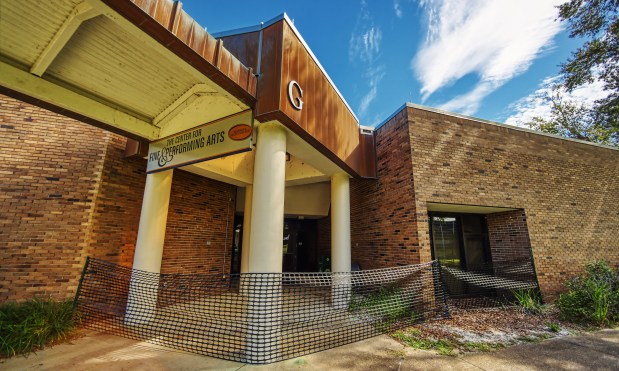Four years after a sinkhole abruptly shut the arts building on the Sanford/Lake Mary campus of Seminole State College, students continue to work in science labs repurposed as art studios, in a small theater space created by the school, and in venues around the area.
There are fewer students needing such amenities, however: Since the closure of the Center for Fine and Performing Arts, enrollment in the college’s arts programs has fallen by nearly 40%. And the sinkhole has cost the institution more than students: Seminole State has already spent $1.5 million on the building but still doesn’t know when it will be able to reopen.
“We want to stress that fine and performing arts are an important part of the college and our community,” wrote Mark Richardson, the college’s manager of public relations and communications, in response to questions from the Orlando Sentinel, “The repair process has been lengthy and complex, but we remain committed to our arts programs.”
The building was erected in 1974, though the original contractor is unknown, Richardson said. Adding to the complexity of getting the building up and running again: Structural issues with the original construction.
Seminole State sinkhole can’t sink concerts, art or theater season
“During an inspection of the building, it was discovered that structural walls do not meet current building codes,” Richardson said. “This will be addressed during the repair process of the building.”
Some progress has been made. In January 2020, “an analysis of the interior boring and sampling indicated that the sinkhole has been adequately stabilized,” Richardson said.
Sinkholes are particularly common in Florida, according to the state Department of Environmental Protection and Florida Geological Survey, which says there are no “safe areas.”
“Since the entire state is underlain by carbonate rocks, sinkholes could theoretically form anywhere,” its website says.

The Seminole State sinkhole was discovered by employees in May 2019 when they noticed large cracks forming in the building’s interior walls. Eventually, the hole opened under the stage in Harriett’s Theatre, named for the late philanthropist Harriett Lake, who donated $500,000 for both scholarships and necessary renovations to spruce up the venue.
Along with the stage, the college’s extensive script library and projection equipment were among other losses, Richardson said. But one lucky break: The theater’s seats are still in place and usable, he said.
Central Florida is part of Florida’s so-called “Sinkhole Alley,” where two-thirds of insurance claims for sinkhole damage are filed, according to a 2010 report. Nationwide, sinkhole damage costs, on average, at least $300 million per year, according to the U.S. Geological Survey, part of the federal Interior Department.

Insurance has paid out $2,831,929 to Seminole State, Richardson said, and the college has spent $1,585,504 so far. How much more will be needed to make the building operational again is currently unknown. The college is working on the design phase of reconstruction in anticipation of a guaranteed maximum price contract, which will set the upper limit of costs.
“We expect the design assessment to be complete by spring 2024,” Richardson said. “Once this assessment is complete, we’ll have a better idea of the repairs needed (and the cost of those repairs) to safely reopen the building.”
The timeline for reopening will depend on how extensive the rebuild turns out to be.
Seminole State offers associate in arts degrees in theater, music and art, with students completing the prerequisites for various bachelor’s degrees from a four-year state college or university. At the start of the 2018 academic year, 615 students were enrolled in such programs, Richardson said. This fall, enrollment stood at 383.
The college has carved out space for the arts programs in other campus buildings. The public art gallery retains an on-campus presence as well as a location in Sanford City Hall. Music recitals take place on campus, with larger concerts presented at the Ritz Theatre in Sanford and the Lake Mary Events Center.
There’s even a new spot for plays: Le Petit Theatre, designed and built in existing space by theater department technical director Josh Jacobs. And former science classrooms used for adult education have been converted to studio art classrooms.

“We have some storage and access challenges to our classroom materials, as well as reduced space to conduct classes, but are managing well,” Richardson said.
In fact, the college has been honored for its perseverance in maintaining arts instruction and programming, receiving the Seminole County Arts Commission’s Heart for the Arts Award.
Follow me at facebook.com/matthew.j.palm or email me at [email protected]. Find more arts news and reviews at orlandosentinel.com/arts, and go to orlandosentinel.com/theater for theater news and reviews.
